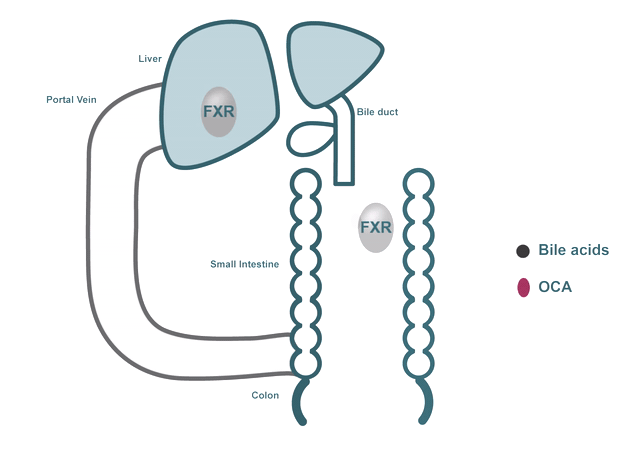Home > Our Research > FXR
Farnesoid X Receptor (FXR)
The Core of Intercept's Research
FXR, a nuclear receptor expressed in the liver and intestine, is a key regulator of bile acid, inflammatory, fibrotic and metabolic pathways.
Understanding FXR
- FXR is a nuclear receptor found in the liver, intestine, kidney, and adipose tissue

- FXR regulates many biological processes, including:
- Bile acid metabolism
- Inflammation
- Fibrosis
- Glucose metabolism
- Lipid metabolism
In addition to their role in digestion and absorption, bile acids have been shown to bind and activate dedicated receptors like FXR.
Intercept's lead compound, obeticholic acid (OCA), is an analog of the bile acid chenodeoxycholic acid (CDCA).
FXR Resources
- Recent insights into farnesoid X receptor in non-alcoholic fatty liver disease (Xu et al, World Journal of Gastroenterology, 2014)
- Pleiotropic roles of bile acids in metabolism (de Aguiar Vallim et al, Cell Metabolism, 2013)
- Physiological and molecular biochemical mechanisms of bile formation (Reshetnyak, World Journal of Gastroenterology, 2013)
- Bile acid transporters and regulatory nuclear receptors in the liver and beyond (Halilbasic et al, Journal of Hepatology, 2012)
- Deciphering the nuclear bile acid receptor FXR paradigm (Modica et al, Nuclear Receptor Signaling, Nov 2010)
- Role of nuclear receptors for bile acid metabolism, bile secretion, cholestasis, and gallstone disease (Claudel et al, Biochimica et Biophysica Acta, 2010)
- Role of bile acids and bile acid receptors in metabolic regulation (Lefebvre et al, Physiological Review, 2009)
- Bile acids as regulatory molecules (Hylemon et al, Journal of Lipid Research, 2009)
- The role of FXR in disorders of bile acid homeostasis (Eloranta et al, Physiology, 2008)
- 6-α-ethyl-chenodeoxycholic acid (6-ECDCA), a potent and selective FXR agonist endowed with anticholestatic activity (Pellicciari et al, Journal of Medicinal Chemistry, 2002)
- Identification of a nuclear receptor that is activated by farnesol metabolites (Forman et al, Cell, 1995)
- Isolation of proteins that interact specifically with the retinoid X receptor: two novel orphan receptors (Seol et al, Molecular Endocrinology, 1995)
YOU ARE NOW leaving interceptpharma.com
You are now leaving Intercept Pharmaceuticals’ corporate website and entering a site intended for U.S. audiences only.
YOU ARE NOW leaving interceptpharma.com
You are now leaving Intercept Pharmaceuticals’ corporate website. Intercept does not control or endorse the content of this external site.
YOU ARE NOW leaving interceptpharma.com
The link you have selected will take you outside of Intercept Pharmaceuticals’ corporate website.
The site you will be entering is intended for U.S. audiences only.
If you are a healthcare provider looking for product information, visit ocalivahcp.com.
YOU ARE NOW leaving interceptpharma.com
You have selected a link that will take you to a site maintained by a third party who is solely responsible for its contents. Intercept provides this link as a service to its website visitors. Intercept is not responsible for the content or the privacy policy of any third party websites.
Close this window to return to Intercept Pharmaceuticals’ site or click ‘Continue’ to proceed.
United States (US)
European Union (EU)
Canada
Israel
Switzerland
Australia
Liechtenstein
United Arab Emirates (UAE)
Exploring Racial Differences and Disparities in PBC Care